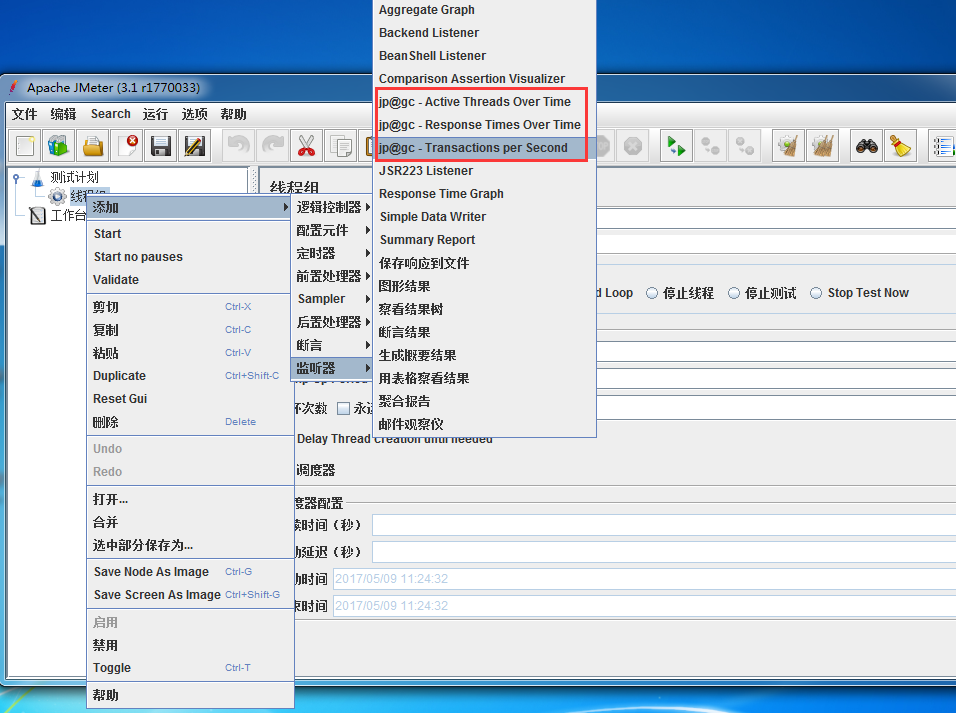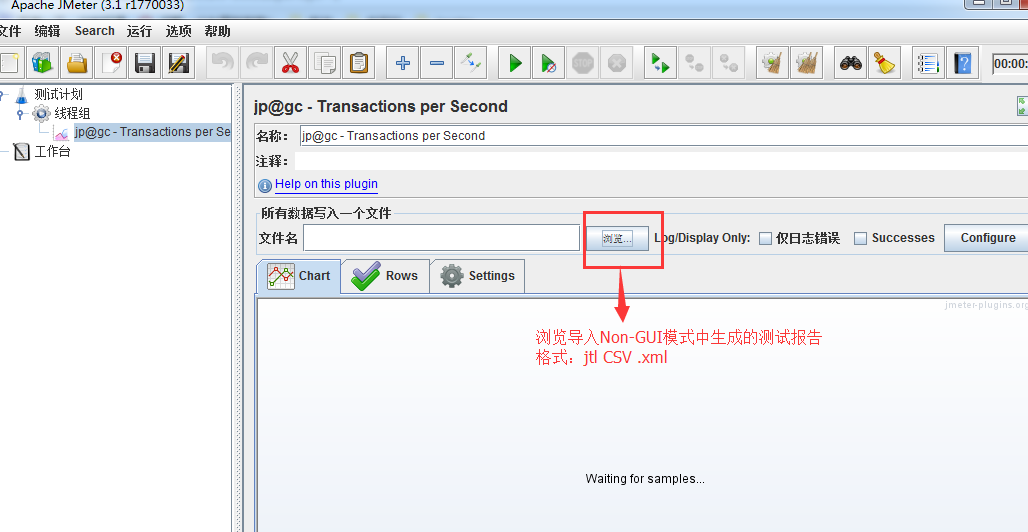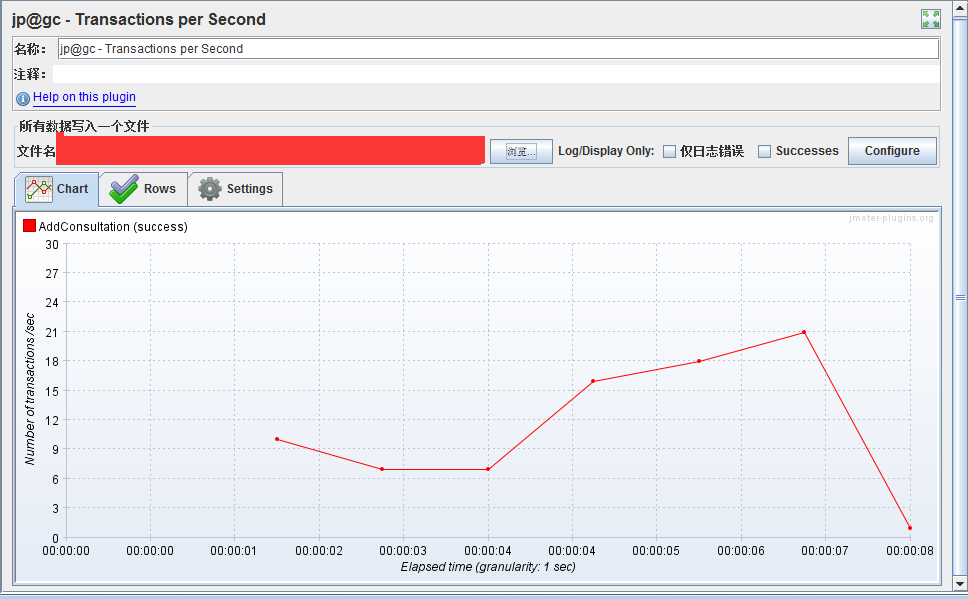Jmeter之http性能测试实战 非GUI模式压测 NON-GUI模式 结果解析TPS——干货(十一)
- 性能测试计划
- 性能测试用例
- 录制脚本
- 性能测试结果
- 性能测试报告
- 性能测试监控报告
准备工作
- 从脚本已录制成功之后开始进行压测
- 安装Jmeter拓展插件 查看 Transactions per Second https://jmeter-plugins.org/wiki/TransactionsPerSecond/ ←插件地址
- 在压测前先安装 Nmon监控工具在服务器linux性能监控分析及通过nmon_analyse生成分析报表
PS :安装 TPS教程
解压安装
将 jpgc-graphs-basic-2.0.zip 解压缩后只有一个 lib 目录,该目录下有一个 ext 文件夹和一个 jmeter-plugins-cmn-jmeter-0.3.jar 包,ext 文件夹中有 jmeter-plugins-graphs-basic-2.0.jar 和 jmeter-plugins-manager-0.10.jar 包。
将 lib 目录下的 jmeter-plugins-cmn-jmeter-0.3.jar 拷贝到 %JMeter%/lib 目录下,将 ext 目录下的 jmeter-plugins-graphs-basic-2.0.jar 和 jmeter-plugins-manager-0.10.jar 拷贝到 %JMeter%/lib/ext 目录下,重启 JMeter,发现已经支持 TPS、TRT 等视图了:

TPS导入解析测试报告

导入之后就可以看到 TPS数据了

取至Jmeter官方文档
1.0.2 Load Test running
Once your Test Plan is ready, you can start your Load Test. The first step is to configure the injectors that will run JMeter, this as for any other Load Testing tool includes:
- Correct machine sizing in terms of CPU, memory and network
- OS Tuning
- Java setup: Ensure you install the latest version of Java supported by JMeter
- Correct sizing of Java Heap. By default JMeter runs with a heap of 512MB, this might not be enough for your test and depends on your test plan and number of threads you want to run
Once everything is ready, you will use Command-line mode (called Non-GUI mode) to run it for the Load Test.
Don't run load test using GUI mode !
不要使用GUI模式运行负载测试!因为GUI模式的话会占用比较大的内存空间,并发数量上不去等等的问题
Using Non-GUI mode, you can generate a CSV (or XML) file containing results and have JMeter generate an HTML report at end of Load Test. JMeter will by default provide a summary of load test while it's running.
You can also have real-time results during your test using Backend Listener.
NON-GUI模式允许得到结果后可以在后端监听器的测试期间获得实时结果。这句话如何理解呢,见上面“TPS导入解析测试报告”
Running JMeter
To run Apache JMeter in NON_GUI
直接进入脚本路径,输入 Jmeter的启动路径
可以查看到Jmeter的相关命令帮助
小七的Jmeter路径是安装在D:\Jmeter\jmeter-3.1 所以直接进入bin目录下 找到jmeter 查看H帮助文档

C:\Users\lamw\Desktop\lamw
λ D:\Jmeter\jmeter-3.1\bin\jmeter -h
Writing log file to: C:\Users\lamw\Desktop\lamw\jmeter.log
_ ____ _ ____ _ _ _____ _ __ __ _____ _____ _____ ____
/ \ | _ \ / \ / ___| | | | ____| | | \/ | ____|_ _| ____| _ \
/ _ \ | |_) / _ \| | | |_| | _| _ | | |\/| | _| | | | _| | |_) |
/ ___ \| __/ ___ \ |___| _ | |___ | |_| | | | | |___ | | | |___| _ <
/_/ \_\_| /_/ \_\____|_| |_|_____| \___/|_| |_|_____| |_| |_____|_| \_\ 3.1 r1770033
Copyright (c) 1999-2016 The Apache Software Foundation
To list all command line options, open a command prompt and type:
jmeter.bat(Windows)/jmeter.sh(Linux) -?
--------------------------------------------------
To run Apache JMeter in GUI mode, open a command prompt and type:
jmeter.bat(Windows)/jmeter.sh(Linux) [-p property-file]
--------------------------------------------------
To run Apache JMeter in NON_GUI mode:
Open a command prompt (or Unix shell) and type:
jmeter.bat(Windows)/jmeter.sh(Linux) -n -t test-file [-p property-file] [-l results-file] [-j log-file]
--------------------------------------------------
To run Apache JMeter in NON_GUI mode and generate a report at end :
Open a command prompt (or Unix shell) and type:
jmeter.bat(Windows)/jmeter.sh(Linux) -n -t test-file [-p property-file] [-l results-file] [-j log-file] -e -o [Path to o
utput folder]
--------------------------------------------------
To generate a Report from existing CSV file:
Open a command prompt (or Unix shell) and type:
jmeter.bat(Windows)/jmeter.sh(Linux) -g [csv results file] -o [path to output folder (empty or not existing)]
--------------------------------------------------
To tell Apache JMeter to use a proxy server:
Open a command prompt and type:
jmeter.bat(Windows)/jmeter.sh(Linux) -H [your.proxy.server] -P [your proxy server port]
---------------------------------------------------
To run Apache JMeter in server mode:
Open a command prompt and type:
jmeter-server.bat(Windows)/jmeter-server(Linux)
---------------------------------------------------
上面包含了一些参数 可以输入 -l 查看
C:\Users\lamw\Desktop\lamw
λ D:\Jmeter\jmeter-3.1\bin\jmeter -l
Usage
--?
print command line options and exit
-h, --help
print usage information and exit
-v, --version
print the version information and exit
-p, --propfile <argument>
the jmeter property file to use
-q, --addprop <argument>
additional JMeter property file(s)
-t, --testfile <argument>
the jmeter test(.jmx) file to run
-l, --logfile <argument>
the file to log samples to
-j, --jmeterlogfile <argument>
jmeter run log file (jmeter.log)
-n, --nongui
run JMeter in nongui mode
-s, --server
run the JMeter server
-H, --proxyHost <argument>
Set a proxy server for JMeter to use
-P, --proxyPort <argument>
Set proxy server port for JMeter to use
-N, --nonProxyHosts <argument>
Set nonproxy host list (e.g. *.apache.org|localhost)
-u, --username <argument>
Set username for proxy server that JMeter is to use
-a, --password <argument>
Set password for proxy server that JMeter is to use
-J, --jmeterproperty <argument>=<value>
Define additional JMeter properties
-G, --globalproperty <argument>=<value>
Define Global properties (sent to servers)
e.g. -Gport=123
or -Gglobal.properties
-D, --systemproperty <argument>=<value>
Define additional system properties
-S, --systemPropertyFile <argument>
additional system property file(s)
-L, --loglevel <argument>=<value>
[category=]level e.g. jorphan=INFO or jmeter.util=DEBUG
-r, --runremote
Start remote servers (as defined in remote_hosts)
-R, --remotestart <argument>
Start these remote servers (overrides remote_hosts)
-d, --homedir <argument>
the jmeter home directory to use
-X, --remoteexit
Exit the remote servers at end of test (non-GUI)
-g, --reportonly <argument>
generate report dashboard only, from a test results file
-e, --reportatendofloadtests
generate report dashboard after load test
-o, --reportoutputfolder <argument>
output folder for report dashboard
下面我们就采用 NON_GUI模式执行脚本 如下:
-------------------------------------------------- To run Apache JMeter in NON_GUI mode and generate a report at end :
Open a command prompt (or Unix shell) and type: jmeter.bat(Windows)/jmeter.sh(Linux) -n -t test-file [-p property-file] [-l results-file] [-j log-file] -e -o [Path to o
utput folder] --------------------------------------------------
输入以下命令直接执行录制好的脚本文件 C:\Users\lamw\Desktop\lamw
λ D:\Jmeter\jmeter-3.1\bin\jmeter.bat -n -t test.jmx -l test_report_01.csv -e -o test_report_01 命令解析:
C:\Users\lamw\Desktop\lamw 这个是测试脚本所在的文件目录

D:\Jmeter\jmeter-3.1\bin\jmeter.bat --------Jmeter.bat 的执行路径
-n, --nongui -------------以nongui模式执行
run JMeter in nongui mode
-t, --testfile <argument>-------------压测脚本文件jmx
the jmeter test(.jmx) file to run
-l, --logfile <argument>-------------将样本记录到的文件
the file to log samples to
-e, --reportatendofloadtests------------ 在加载测试后生成报告仪表板
generate report dashboard after load test
-o, --reportoutputfolder <argument>---------------- 报告仪表板的输出文件夹
output folder for report dashboard
运行脚本进行压测


当然,在运行脚本进行压测的时候 需要在服务器 先执行 采集命令
ps -ef | grep nmon 查看采集数据的进程
[root@lamw /home/lam7/nmon]# ps -ef | grep nmon
[root@lamw /home/lam7/nmon]# nmon -f -s 1 -c 60
-f 表示生成的数据文件名中有时间;
-t 输出中包括占用率较高的进程;
-s 1 表示每 1 秒采集一次数据;
-c 60 表示采集 60 次,1s*60=60秒;
至于监控的方式可以查看上面所讲的准备工作第三点
Jmeter之http性能测试实战 非GUI模式压测 NON-GUI模式 结果解析TPS——干货(十一)的更多相关文章
- Jmeter(一)非GUI模式压测(NON-GUI模式)结果解析TPS
非GUI模式压测(NON-GUI模式)结果解析TPS 准备工作 从脚本已录制成功之后开始进行压测 安装Jmeter拓展插件 查看 Transactions per Second https://jme ...
- Jmeter之http性能测试实战 NON-GUI模式 进行分布式压力测试——干货(十二)
Apache JMeter Distributed Testing Step-by-step This short tutorial explains how to use multiple syst ...
- JMeter-命令行模式压测
前言 使用非GUI模式,即命令行模式运行jmeter测试脚本能够大大缩减系统资源,今天跟小伙伴们讲一下JMeter如何在命令行模式进行压测吧! 一:配置好JDK和JMeter的环境变量(过程略) 二: ...
- Jmeter之TCP取样器(模拟数据上报压测)
TCP压测 场景:模拟硬件设备上报数据(登录,心跳,GPS定位数据/光感数据/电量数据),对这个功能进行压测 啰嗦一句:TCP压测很简单,只要调通了一个TCP,后续的逻辑判断就用逻辑控制器和正则处理就 ...
- SwingBench 字符模式压测最佳实践
之前写过<使用SwingBench 对Oracle RAC DB性能 压力测试>,使用的是最基础直观的图形模式,已经可以满足大多数需求. 但是在有些场景下,图形模式可能本身消耗资源过大,尤 ...
- my31_MGR单写模式压测以及对比普通从库记录
场景MGR单写模式三节点,db46写节点,db47/db48为读节点工具sysbencn.压测15个小时,db46上18线程纯写,12线程oltp混合测试,db48上12线程select在压测2个小时 ...
- jmeter+nmon+crontab简单的执行接口定时压测
一.概述 临时接到任务要对系统的接口进行压测,上面的要求就是:压测,并发2000 在不熟悉系统的情况下,按目前的需求,需要做的步骤: 需要有接口脚本 需要能监控系统性能 需要能定时执行脚本 二.观察 ...
- jmeter之登录接口的一次简单压测与分析
前言:登录接口的一次简单压测与分析 1.接口文档 2.配置元件 3.结果分析 1.接口文档 a.拿到接口文档 接口地址:http://localhost:8080/jpress/admin/login ...
- Jmeter系列(12)- 上传接口压测
step-1上传接口分析 上传接口源码分析:分析上传文件类型.有无大小限制.存放上传文件服务器 没有源码通过抓包工具,或者Chrome查看框架源代码 接口路径/uploadfile,接口请求POST, ...
随机推荐
- Django---->视图(View)
视图层之路由配置系统(views) URL配置(URLconf)就像Django 所支撑网站的目录.它的本质是URL与要为该URL调用的视图函数之间的映射表:你就是以这种方式告诉Django,对于这个 ...
- 大数据学习系列之九---- Hive整合Spark和HBase以及相关测试
前言 在之前的大数据学习系列之七 ----- Hadoop+Spark+Zookeeper+HBase+Hive集群搭建 中介绍了集群的环境搭建,但是在使用hive进行数据查询的时候会非常的慢,因为h ...
- 开发高性能JAVA应用程序基础(内存篇)
虽然Java的垃圾回收和当前高配置的服务器可以让程序员大部分时间忘掉OutOfMemoryError的存在,但是访问量增大后频繁的GC会额外消耗CPU (使用top查看结果为us值高),系统响应速度下 ...
- Java A+B(个人模版)
JavaA+B: import java.io.*; import java.util.*; import java.math.BigInteger; import java.util.Scanner ...
- hdu_1041(Computer Transformation) 大数加法模板+找规律
Computer Transformation Time Limit: 2000/1000 MS (Java/Others) Memory Limit: 65536/32768 K (Java/ ...
- 2017ecjtu-summer training #4 UESTC 1584
此题链接 http://acm.uestc.edu.cn/#/problem/show/1584 此题和hdu1541几乎完全一样,我们要先对坐标排序,再进行操作. hdu1541题解 http:// ...
- c++(hash表)
hash表,有时候也被称为散列表.个人认为,hash表是介于链表和二叉树之间的一种中间结构.链表使用十分方便,但是数据查找十分麻烦:二叉树中的数据严格有序,但是这是以多一个指针作为代价的结果.hash ...
- MVC学习笔记(分享)
一.SpringMVC基础入门,创建一个HelloWorld程序 1.首先,导入SpringMVC需要的jar包. 2.添加Web.xml配置文件中关于SpringMVC的配置 <!--conf ...
- 常用Windows DOS命令项目部署经常用到
img { max-width: 100% } 前两天部署.netcore项目,首先是生产环境域名访问不了,再到.netcore项目IIS部署502.5,在到莫名其妙的500,在排查项目部署问题的时候 ...
- 应用fstream格式化输出
我举一个我应用的例子 file.open("shoroud.jrf" ,ios_base::trunc); //打开文件,清空文件内容 if(!file.good()) { pri ...
